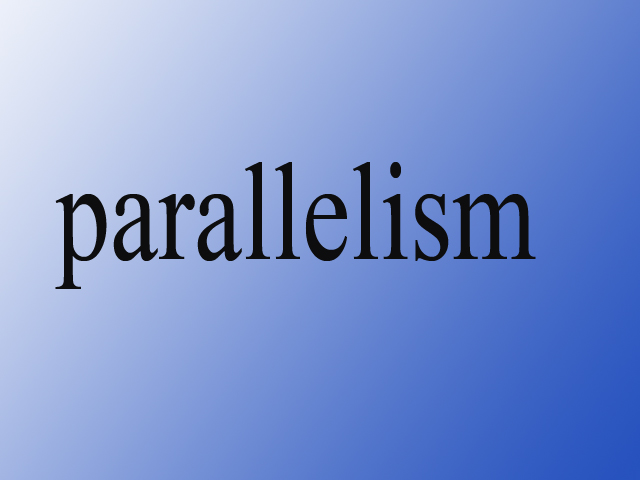Parallelism
Parallelism is having a parallel structure within the sentence structure
Parallelism
Be strong, but not rude;
Be kind, but not weak;
Be humble, but not timid.
JIM ROHN
Parallel (def.): to be side by side or to be in a similar way.
You might have found the above quote catchy, where there are three sentences; each one starts with the imperative verb be,followed by an adjective, and after that comes the contrast using but followed by not + adjective. This repetition creates symmetry and is pleasurable to read or to hear.
What’s Parallelism?
Parallelism creates similar words, phrases, or clauses.
Parallelism uses the same structure and construction.
Examples:
1- Put sugar, add flour, mix eggs then combine them.
Parallelism occurs here, verb + noun, verb +noun, verb + noun
X Put sugar, flour, eggs, then combine them.
In the second example, it isn’t a parallel structure. The sentence started with a single verb then three nouns, there isn’t any balancing of the verbs with the nouns like in the first example.
3- But, in a broader sense, we cannot dedicate — we cannot consecrate — we cannot hallow — this ground. Abraham Lincoln
– You can see the parallelism in we – cannot + verb repeated in the underlined sentences.
Parallel Structure:
A parallel structure is when conjunctions (but, and, or and nor) tie words or phrases that have the same grammatical form.
Form and Usage
noun + or + noun
- They can get money or food.
verb + but + verb
- My son wanted to travel, but he stayed with me.
adjective + and + adjective
- The motorcycle is red, speedy, and enormous.
Note: When we have multiple units in the parallel structure, use a comma to separate them from each other.
- The weather was rainy, windy, and cold.
- Martin sold his car, borrowed some money,and asked for a loan.
adverbs + and + adverb
- The kid passed his exams anxiously, angrily, and badly.
- X The kid passed his exams anxiously, angrily and in a bad way.
verb + and + verb
His brother works in a library and works in a grocery store.
Paired Conjunctions:
Form and Usage:
parallelism
both ………………. and (positive sentences)
both + noun + and + noun
- He’s both a physician and an army officer.
both + adjective + and + adjective
- The students are both witty and quick.
either ………………. or (alternatives)
either + verb/phrase + or + Verb/Phrase
- You can either study architecture or study arts.
Either + singular noun + or + singular Noun + singular verb.
- Either Mark or Hank goes to the bank.
neither ………………. nor (negative – exclusion)
neither + verb + nor + verb
- They can neither ridethe boat nor takethetrain.
Neither + Singular Noun + nor + Singular Noun + Singular verb.
- Neither Nero nor his fatheris short.
not only ………………. but (also) ……………….. (emphatic – in addition to)
Subject + Verb + not only + adjective + but also + adjective
- Samantha is not only beautiful but also intelligent.
Subject + Verb + not only + Adverb + but also + Adverb
- Bony speaks Arabic not only naturally but also fluently.
Subject + Verb + not only + Noun + but also + Noun
- My mother likes not only cake but also chocolate ice-cream.
Subject + not only + Verb + but also + Verb
- She not only eats a lot but also drinks tons of water.
-ing form (gerund):
Tim avoided calling, meeting, and seeing her.
Infinitive Phrases:
We decided to stay at home, to cook dinner, and to sleep early.
OR
We decided to stay at home, cook dinner, and sleep early.
we can put “to” before all the verbs in a sentence or only before the first verb.
X Tim avoided calling, meeting and to see her.
We can’t mix gerund form with an infinitive.
parallelism
Parallelism with clauses:
The doctor informed the players that they must train, that they must sleep early, and that they must eat healthily.
X The doctor informed the players that they must train, that they must sleep early, and to have something healthy to eat.
Parallelism in clauses can’t change from active to passive.
They told me that he would come to me early this morning, that he would ask for my number, and that he would call me.
X They told me that he would come early this morning, that he would ask for my number, and that I would be called.
Lists after a colon
Keep all the elements in a list in the same form, don’t forget to place the commas
You can find these in a bookstore: newspapers, comics, and books.
X You can find these in a bookstore: newspapers, comics and reading books.
Why Parallelism?
-Parallelism is fun to read, yet at the same time, it adds clarity to give an accurate understanding.
-Sometimes in a parallel structure, you’ll find contrast and comparison, which makes it easy to read and understand.
-Parallelism is significant in stating items in a list or stating the properties of something.
Examples:
Let every nation know, whether it wishes us well or ill, that we shall pay any price, bear any burden, meet any hardship, support any friend, oppose any foe to assure the survival and the success of liberty. JFK
– There’s a contrast between the nouns well– ill, joined by the conjunction or.
– There’s a repetition of a verb + any + noun in five consecutive sentences. These sentences look like they are a list for the goal (to assure the survival and the success of liberty).
Parallelism
Parallelism explanation and practice (SAT – ACT – EST) |
you can find us on Facebook


wdsaaaaaaaaaa